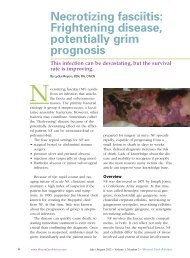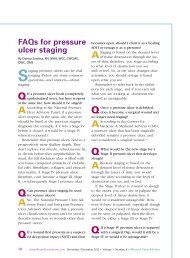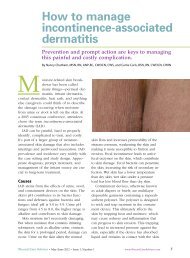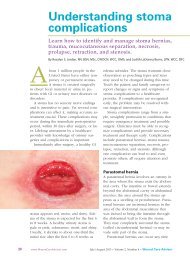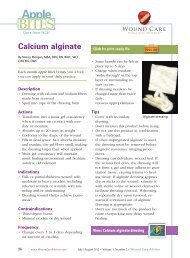PPCO Twist System - Wound Care Advisor
PPCO Twist System - Wound Care Advisor
PPCO Twist System - Wound Care Advisor
You also want an ePaper? Increase the reach of your titles
YUMPU automatically turns print PDFs into web optimized ePapers that Google loves.
consider ablative therapy if symptoms do<br />
not improve after 6 months of conservative<br />
therapy or if the patient seeks cosmetic<br />
improvement. Ablative therapy refers to<br />
the various types of therapy that destroy<br />
or remove the abnormal veins.<br />
Types of ablative therapy include chemical,<br />
thermal, and mechanical techniques.<br />
• Chemical ablation consists of placing an<br />
irritating fluid directly into the vein,<br />
which damages the endothelial lining<br />
and leads to the destruction of the abnormality.<br />
This method is used mainly<br />
for telangiectasia, reticular veins, and<br />
small varicose veins. To treat larger veins<br />
without having to use large amounts of<br />
fluid, an ablative foam solution can be<br />
used instead; this may be done for larger<br />
varicosities, incompetent saphenous<br />
veins, or incompetent perforating veins.<br />
• Thermal ablation uses a form of heat<br />
energy that destroys the wall of the vein.<br />
It may be used with topical light therapy<br />
applied to the skin for small, superficial<br />
dilated veins (telangiectasia or reticular<br />
veins). For larger veins (greater or lesser<br />
saphenous veins), heat energy may be<br />
applied within the vein itself using laser<br />
or radiofrequency energy.<br />
• Mechanical ablation physically destroys<br />
or removes the abnormal vein. Examples<br />
of this technique include surgical<br />
vein ligation and vein stripping. (See<br />
Ablation success rates.)<br />
Ablation success rates<br />
Here are the overall 3-year success rates for ablative<br />
therapy:<br />
• foam sclerotherapy: 77%<br />
• vein stripping: 78%<br />
• radiofrequency ablation: 84%<br />
• laser ablation: 94%<br />
Correct identification is crucial<br />
In a patient with suspected CVI, wound<br />
care clinicians must be able to correctly<br />
identify the disease process and determine<br />
if significant comorbid diseases are present<br />
before prescribing or administering any<br />
form of therapy. Otherwise, the therapy<br />
ordered may not correct the problem—and<br />
could even cause harm. Various diagnostic<br />
tools are available; in practice, ultrasonography<br />
is most often used for diagnosing<br />
venous disease.<br />
Multiple therapeutic modalities are available<br />
to treat CVI. Unless the disease is corrected,<br />
the patient will need lifelong compression<br />
therapy. How much compression<br />
that can be safely applied depends on the<br />
presence and extent of comorbidities, such<br />
as PAD and heart failure.<br />
n<br />
Selected references<br />
Alguire PC, Mathes BM. Clinical evaluation of lower<br />
extremity chronic venous disease. UpToDate. Last<br />
updated April 18, 2012. www.uptodate.com/contents/<br />
clinical-evaluation-of-lower-extremity-chronic-venousdisease.<br />
Accessed April 11, 2013.<br />
Alguire PC, Mathes BM. Diagnostic evaluation of<br />
chronic venous insufficiency. UpToDate. Last updated<br />
May 7, 2102. www.uptodate.com/contents/<br />
diagnostic-evaluation-of-chronic-venous-insufficiency<br />
?source=search_result&search=Diagnostic+evaluation<br />
+of+chronic+venous+insufficiency&selectedTitle=<br />
1%7E128. Accessed April 11, 2013.<br />
Alguire PC, Scovell S. Overview and management of<br />
lower extremity chronic venous disease. UpToDate.<br />
Last updated June 27, 2012. http://www.uptodate.com/<br />
contents/overview-and-management-of-lowerextremity-chronic-venous-disease?source=search_<br />
result&search=Overview+and+management+of+<br />
lower+extremity+chronic+venous+disease&selected<br />
Title=1%7E150. Accessed April 11, 2013.<br />
Moneta G. Classification of lower extremity chronic<br />
venous disorders. UpToDate. Last updated October<br />
22, 2012. www.uptodate.com/contents/classificationof-lower-extremity-chronic-venous-disorders.<br />
Accessed<br />
April 11, 2013.<br />
Sardina D. Skin and <strong>Wound</strong> Management Course;<br />
Seminar Workbook. <strong>Wound</strong> <strong>Care</strong> Education Institute:<br />
2011;92-112.<br />
Donald A. Wollheim is a practicing wound care<br />
physician in southeastern Wisconsin. He also is<br />
an instructor for <strong>Wound</strong> <strong>Care</strong> Education Institute<br />
and Madison College. He serves on the Editorial<br />
Board for <strong>Wound</strong> <strong>Care</strong> <strong>Advisor</strong>.<br />
<strong>Wound</strong> <strong>Care</strong> <strong>Advisor</strong> • May/June 2013 • Volume 2, Number 3 www.<strong>Wound</strong><strong>Care</strong><strong>Advisor</strong>.com 27



